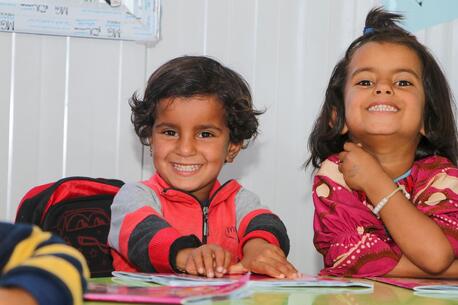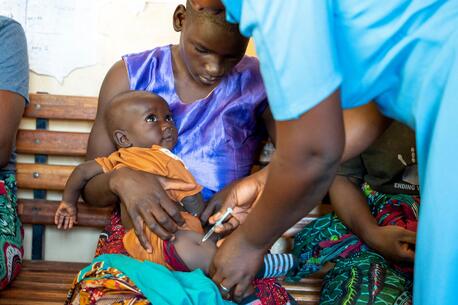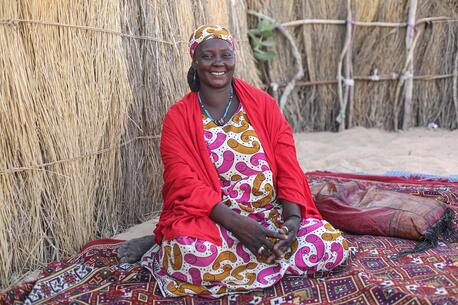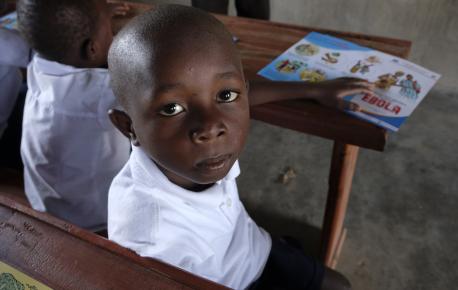
Sponsor a Child Today
Thinking of sponsoring a child? After more than 75 years working to save and protect children around the world, UNICEF has found that the most effective way to help one child in a community is through sustainable solutions designed to help them all. Instead of sponsoring one child, consider supporting a mission that has helped save more children than any other organization by giving every child the chance to thrive.
The COVID-19 pandemic affected families all over the world, taking far too many lives, closing schools and straining social systems. For the most vulnerable children, it was a crisis on top of a crisis.
Children are malnourished in many countries around the world, from Afghanistan to Yemen, Ethiopia and Somalia and South Sudan. In Syria, Iraq and Jordan, children have been driven by war into tent settlements, where without proper winter clothing, boots and blankets, they struggle to survive the cold.
For all of them, the clock is ticking.
When children are suffering halfway around the world, it’s hard to know how to help. Do you donate to an organization like UNICEF, which seeks to solve the problems all children face, or do you look for a charity that allows you to sponsor one specific child?
Child sponsorship organizations take a different approach
Some child sponsorship programs allow donors to make monthly funding commitments to support individual children, with whom they may correspond and even visit to see the impact of their support. For people who want to know they've made a contribution toward improving the life of one particular child, the idea of child sponsorship can be quite compelling.
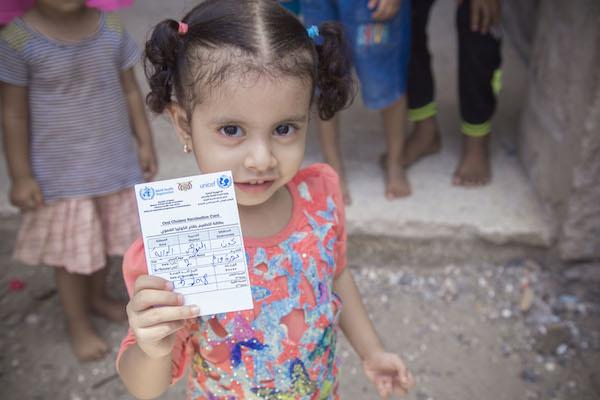
UNICEF launched the first-ever Oral Cholera Vaccination campaign in Yemen, where conflict, a deteriorating economic situation and little to no access to safe drinking water and sanitation sparked the world’s largest cholera outbreak. Thanks to a UNICEF immunization, this 6-year-old girl is safe. © UNICEF/UN0209184/Bafaqeh
However, although child sponsorship programs have been around since the 1930s, a 2017 national study of 1,000 American charity supporters by Grey Matter Research and Opinions 4 Good, found that only 24 percent of respondents truly understood what it means to sponsor a child.
“Most donors are aware of sponsorship and generally positive toward it, but there is not a lot of real familiarity with how it works,” says Ron Sellers, president of Grey Matter Research. “The interest is there, but so are doubts or concerns.”
What does it mean to sponsor a child?
It depends on the organization.
Though many organizations offer information about specific children who need help and the opportunity to keep in touch with them, that doesn’t necessarily mean that supporters’ monthly donations actually go to the child’s family. Rather, many organizations have found that they can do much more good by pooling sponsor funds in order to attack the problems facing the communities where the children live with long-term, sustainable solutions.
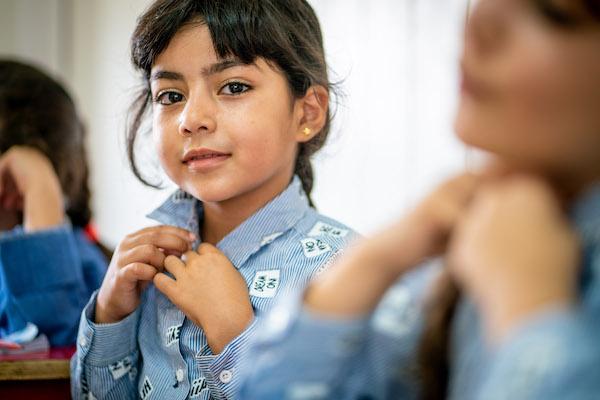
Aia (above) is 7 years old. She loves to learn at UNICEF’s child-friendly Makani Center in the Za’atari refugee camp, in Jordan, where she and other children who fled war in Syria live. “I like to study here. They teach me math, English and Arabic," says her 8-year-old sister, Zana (far right), who believes that going to the Makani Center, which offers learning and social and emotional support, has helped bring up her grades. "I want to become a doctor so I can treat sick people. I love learning.” © UNICEF/UN0263706/Herwig
While many child sponsorship programs now taking this approach offer donors the chance to get to know individual children in the communities where the organizations work, the children supporters correspond with aren’t always the direct recipients of donors’ monthly checks. Rather, some organizations designate the children sponsors get to know as unofficial ambassadors for their communities.
UNICEF offers an alternative to child sponsorship
What’s the best way to sponsor a child? After more than 75 years working to save and protect children around the world, UNICEF has found that the most effective way to help one child in a community is through sustainable solutions designed to help them all.
With a presence in over 190 countries and territories, UNICEF has helped save more children's lives than any other humanitarian organization by providing health care, immunizations, safe water, nutrition, education, emergency relief and more to communities at scale.
It’s that approach that has allowed UNICEF to address inequity at its root and deliver what all children need to survive and thrive.
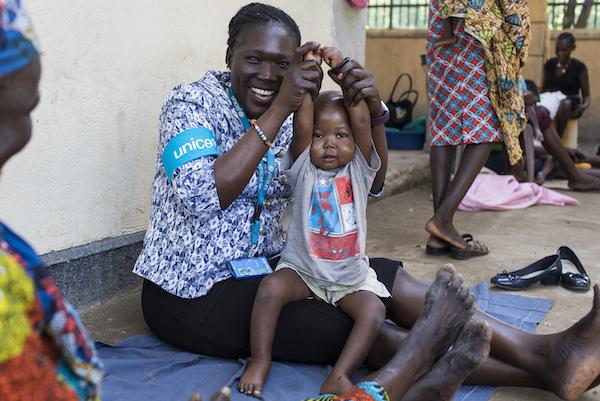
Meet Gift. He lives in South Sudan, where 60% of the war-torn nation’s people don’t know where their next meal is coming from. He was hospitalized for severe acute malnutrition for 10 days. Thanks to UNICEF, he made a full recovery. © UNICEF/UN0232159/Njiokiktjien VII Photo
Year after year, UNICEF and partners make a lifesaving difference for millions of children
treating millions of children for severe acute malnutrition
vaccinating millions of children against measles
connecting out-of-school children with early learning, primary and secondary education opportunities
improving access to safe water for drinking, cooking annd personal hygiene
helping families survive crises with cash transfer programs
reaching children traumatized by war with mental health care and psychosocial support
reaching children who live under the threat of landmines and other explosive weapons with prevention and survivor assistance
How much does it cost to become a child sponsor with UNICEF USA?
UNICEF works from the top down, partnering with governments to help shape policies and programs while making connections in communities to put them into action.
That access, combined with the ability to ship supplies anywhere in the world within 72 hours, ensures UNICEF can leverage resources and deliver supplies quickly and efficiently to make donor support really count.
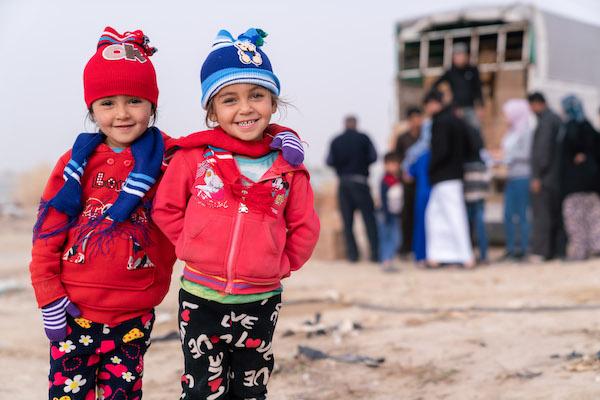
Sita and her sister, Tawaseef, just received winter gear from UNICEF, including the first pair of warm winter boots they've ever owned. The girls, whose family fled the war in Syria, now have the protection they'll need to make it through winter in the Jordan tent settlement they call home. “I like the boots the most!" says Tawaseef, who previously had only sandals to wear. “The scarf is soft," says Sita. "I love it!” © UNICEF/UN0274601/Herwig
That means donors can rest assured knowing that UNICEF will provide children with the best lifesaving supplies and programs money can buy. Some examples of how far UNICEF can make your support go:
- $29 = soap to support family health and hygiene: A gift of $29 is enough to provide 100 bars of soap to health centers, where regular handwashing is vital to preventing the spread of infection, or to help ensure children can keep their hands clean while they are at school or visiting UNICEF Child-Friendly Spaces
- $51 = Measles vaccines for 50 children: Measles is highly contagious and is a leading cause of death among children; the measles vaccine is one of the most successful public health interventions in human history, but lapses in immunization coverage lead to avoidable outbreaks
- $60 = two-month supply of Ready-to-Use Therapeutic Food: RUTF is a lifesaving treatment for children with severe acute malnutrition; a two-month supply of RUTF packets — which are easy to administer at home and require no refrigeration or mixing with water — is enough to bring a listless child back to good health
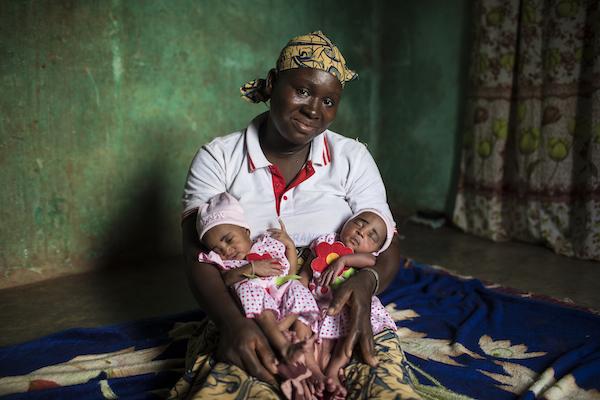
Fatoumata of Bougouni, Mali, here with her twin daughters Foune and Wassa, has five children. All of them have received a full course of immunizations thanks to UNICEF. "My five children are very healthy," she says. "It is because of the vaccines." ©UNICEF/UN0198195/Njiokikjtien VII Photo
What's the best way to help children?
The single most effective way you can help UNICEF fight for every child, everywhere, is by becoming a monthly donor.
A small monthly gift can make a huge difference in the lives of so many children by providing steady funding that allows UNICEF to be on the ground before, during and after a crisis, providing the protection, nutrition, health care, safe water and education children need month after month.
After meeting Baby Yasmin and her big sisters in inland Bahia, Brazil, UNICEF and partners got the older girls into school. Now they — and Yasmin — have a chance to break the cycle of illiteracy that consigned their mother and grandmother to a life of poverty. © UNICEF/UN0225944/Libório
Monthly Donors receive:
a dedicated team to answer questions via email or phone
quarterly 8-page newsletter with updates on children UNICEF is helping thanks to generous donors like you
annual statements to make tax time easier
an easy-to-use donor portal that simplifies modifying gift amounts, updating payment methods and making other changes, including the timing of donations with the option to cancel at any point
targeted communications in the form of monthly statements detailing giving to date
Save a child. Become a monthly donor now.
Top photo: 7-year-old Kambale of Beni, Democratic Republic of the Congo, sits in his UNICEF-supported classroom, where children are taught to wash hands to prevent the spread of infectious disease.© UNICEF/UN0235943/Nybo
